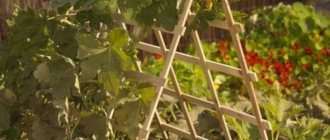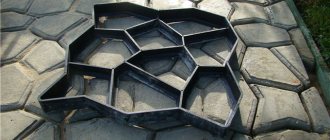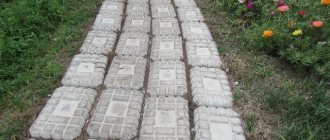Effective methods of landscape design include vertical gardening. A DIY garden trellis is ideal for the process. Climbing plants help make even ordinary garden corners original. The special design is responsible for the decorative and functional task. Any site owner can make a lattice on their own.
What is a garden trellis
The construction of the trellis is not complicated. Modern structures are made from lumber, plastic pipes, metal and polyethylene. Various crops grow well on such a wall.
Durable structures protect the stems from damage. Thanks to its simple design, the plant does not break or get wet from too much moisture. The trellis makes caring for any plant easier. With its help, you can disguise unsightly areas or give a certain direction.
A do-it-yourself garden trellis is a rope structure or lattice tied to a support, which is used for the growth and development of hanging crops. With the help of a trellis, plants can form full-fledged lashes.
When deciding how to make a trellis with your own hands, you should take into account the type of plants and methods of forming the stems. Structures for planting grapes must be rigid and reliable. It is designed for heavy loads.
For cucumber bushes, trellises, nets and devices with high arches are suitable. For tomatoes, supports of medium height are used. When planting roses, you can use trellises made of forged metal and wood. Panels and decorative grids look great.
Requirements for support devices
The choice of a specific type of support must be decided before the plant is planted. The choice is influenced by the height and power of the shoots, the method and degree of attachment to the support.
Primary requirements:
- Reliability and durability. The support should hold the pot well and support the weight of the plant.
- There should be a uniform arrangement of the plant along the support.
- Practicality: the support should not be bulky, the plant should look beautiful and collected in it.
- Safety: the support must be made of natural, environmentally friendly materials.
- The support should have an attractive appearance.
If all requirements are met, the support will perform its functions to the maximum.
Original configurations
The shape of the trellises differs in variety. Arched, double-plane and single-plane structures are in demand. Many gardeners prefer V-shaped and T-shaped varieties.
Simple variations include a single-plane product, including two parallel supports with tensioned cables. Two-plane trellises have bases that are arranged crosswise and have a short and upper longer crossbar. Rows of wires are attached to the ends of the elements. Particularly popular are vertical and lattice structures, which are good for guiding climbing plants. The internal parts have fine-mesh structures or consist of thin parts that are arranged crosswise. The choice of configuration depends on the location of the trellises.
Pergolas
Initially, the arbor had a very practical purpose and served as a support for grapevines with heavy bunches and slopes. Over time, this design, originating from the Mediterranean, has become popular throughout the world and has become increasingly decorative. Although at first pergolas were built as large canopies, now in our yards their sizes can change at the request of the owner.
Indeed, this is an open veranda, attached to the house or separate, in which some of the openings are filled with a thin lattice, beams, curtains, and the role of the roof is played by weaving plants. Building a gazebo is quite simple: you need to make a wooden structure from a powerful beam, if desired, covering some walls with screens or partitions. Then plant grapes, wedding grapes, clematis, climbing roses and other plants that will overwinter in your area without the shelter of arbor supports. In a few years (provided there are mild winters), a real Mediterranean gazebo will decorate your site.
Advantages of trellis structures
Trellis in landscape design has the following advantages::
- Protects against contact of fruits with the surface of the earth. Berries or vegetables remain clean.
- Provides high-quality ventilation, which prevents the appearance of fungal formations.
- Allows you to create uniform lighting.
- Makes watering, pruning and harvesting easier.
The support allows you to disguise unattractive areas in any area. Horizontal variations of supports are used for installing a gazebo. This option allows you to create shade in the area. A trellis is a wonderful device for decorating a garden area.
Pleasant neighborhood - man and climbing plants
Liana-type plants, freely spread throughout the garden, create a unique atmosphere in your green corner. They make the property look like a piece of the jungle - bright, colorful, refreshing and very cozy. There is nothing better than resting in the shade of fragrant plants on a hot day, relaxing and thinking about beauty.
Supports will help you create a unique landscape design
Thanks to the successful placement of climbing plants, your territory becomes more places for relaxation, shady corners formed by fragrant flowers and lush green leaves. Being in such places lifts your spirits and charges you with positive energy. Supports for climbing plants are various devices that allow flowers and other vegetation to fully demonstrate their decorative properties, and gardeners - their design inclinations and wild imagination.
Types of trellises
There are several types of trellis designs that form reliable supports.
Mesh products
Mesh structures are ideal for planting clematis and roses. To create them, meshes with large cells and PVC coating are used. The trellis is resistant to deformation and has the necessary strength.
The installation consists of two supports with a mesh pulled between them. It is not difficult to make such a design, follow these steps: :
- Before arranging the trellis, the elements are marked on the ground.
- Recesses are dug into which wooden or metal support posts are placed.
- The installed elements are painted with paint of a suitable shade. This allows you to protect structures from rot and corrosion.
- Then the mesh is stretched.
Made of wood
Do-it-yourself wooden trellises, which are distinguished by their aesthetics and special beauty, are popular. To make them, you need to stock up on branches, as well as ropes and wire. This is a simple design that does not require complex calculations to install.
Wooden trellises are safe and reliable elements. They go great with any design. Well suited for climbing plants. They look natural and beautiful. They are easy to install and easy to process.
Creating a trellis includes the following steps:
- The branches need to be spread out.
- Each element is installed in the ground, and the second branch is located at an angle of 60 degrees. These parts are then tied with ropes.
- All other branches are intertwined in a similar way.
- The result should be diamonds of the correct configuration, which are fixed with ropes.
- All protruding branches are removed and a rectangular lattice is obtained.
If necessary, the system can be disassembled and stored. Before arranging the structure, it is important to take into account the characteristics of the crops being planted. For some climbing plants, the supports need to be strengthened. For this, a frame made of high-strength wood is used. Fixation can be done with nails or by cementing the supports. A simple structure of branches is more suitable for raspberries, blackberries and climbing roses.
In order for the product to last for many years, it must be treated from moisture. Special impregnations are suitable for this.
Support structures made of plastic pipes
For large climbing crops, do-it-yourself trellises made from plastic pipes are ideal. The structures allow you to create a reliable frame system. They can be used for vineyards.
Structures made from plastic pipes allow you to create any configuration. From flexible elements you can make objects from arches or make an additional veranda near the wall of the house.
To create the structure, clamps are used to connect plastic parts. You also need to prepare reinforcement and a hacksaw to secure the structure into the ground. First, markings are carried out on the territory. Then the structure is built according to certain dimensions.
Plastic elements have many advantages. They are resistant to moisture, stress and temperature changes. To create trellises, small-diameter pipes are suitable that do not interfere with the penetration of light rays.
Made of metal
To decorate the area, you can use metal trellises for climbing plants. Such structures are suitable for the arrangement of climbing crops - cucumbers, grapes and various variations of flowers. And also for shrub plants - raspberries, blackberries and currants.
Before installing structures, it is important to correctly calculate the load and select high-quality materials. The larger the plant, the more stable the reinforcement should be chosen. To place bush varieties, you can use a thin lattice of metal reinforcement connected by posts. The support parts are attached using a special wire. To make the metal mesh more durable, it is necessary to use welding.
Triangular supports
Such plant supports are quite simple garden structures. They are made from ordinary even sticks, which can be cut in the nearest copse. It is better to install such a structure before planting the plants in a permanent place, so as not to damage the delicate roots of the plants.
The process of creating a triangular support is quite simple:
- Prepare the required number of sticks of equal length. Using a knife or hatchet, sharpen the edge that will be installed in the ground.
- Stick the sticks into the ground at an angle towards each other. Depth into the ground - at least 30 cm.
- Place a long stick on top of the formed recess, which will secure the entire structure.
- Tie all the sticks together with soft twine at the junction points.
- Plant climbing plants along the support and wait for them to grow and cover your support with a green blanket.
The triangular support is ideal for plants such as decorative beans, clematis, and sweet peas.
How to make a garden trellis with your own hands
With minimal skills and a set of tools, you can make a garden trellis with your own hands. The design can be either horizontal or vertical. Mixed support structures are popular. They are suitable for attaching tomatoes, cucumbers and grapes.
To make a simple trellis, you need to prepare in advance a ruler, a special solution, wire cutters, a hacksaw and a hammer. For wood products you will also need nails. To build a wall of reinforcement elements you will need wire. To build a trellis from pipes you need to stock up on clamps.
The process of making a trellis includes the following steps:
- First you need to choose the optimal size of the structure. At the planning stage of the garden area, you should decide on the configuration of the trellis. The shape is selected taking into account the type of plant. Combined or vertical support elements are suitable for the vineyard. To place tomatoes, you should choose elongated vertical structures. Cucumbers go well with mixed and vertical meshes. For shrubs, trellises along the perimeter of the bush in the form of a round fence are suitable. Any products are suitable for climbing varieties.
- The necessary parameters and shapes of the walls are entered into the drawing.
- It is important to correctly calculate the weight of the trellis walls, which should exceed the weight of the crops.
- Using a solution, it is necessary to fix the posts into the soil. The supports are installed at a certain distance. If the structure is small, the posts are simply buried in the ground. Then the grille should be placed evenly on the stand.
After installing the wall structure, you can place different varieties of plants. The branches are attached at a certain distance. To strengthen the structure, additional support pillars are used. This will protect the structure from falls even when large liana-like crops grow. To strengthen plastic and wooden elements, you need to use axial parts and special crossbars. To extend the service life of the structure, varnish coatings should be used for processing. When placing a trellis along a path, it is recommended to use not one wide element, but several prefabricated parts.
Useful recommendations and a step-by-step installation plan will allow you to build a functional and beautiful trellis in any area.
Arcs
Plastic and metal arches can be useful not only for covering plants with foil or spunbond, but also for creating support. Arches can be plastic or metal, the main thing is that they are strong enough, hold their shape and are not afraid of frost. The easiest way is to buy ready-made arches in a garden store or at the market, since they are inexpensive, but folding them yourself to make the structure even is not so easy.
Due to the small height of the arches, not all plants can support. It is better to tie short tomatoes, young grape vines, and flowers with thin tall stems to them.
Pyramid stands
By analogy with a conical support, a pyramid is also prepared, but 4 supporting elements are sufficient. These can be fittings, wooden blocks, pipe cutouts, etc. Go deep into their lower parts with a square on a flower bed or ridge and connect the upper ends together by welding or wrapping with wire. Then plant the climbing plants at the base and wait for them to grow.
Grids
Chain-link mesh or plastic structural mesh is similar in principle to a rope holder - it also requires a frame or attachment point. Most often, the wire mesh serves both as part of the fence and as a supporting element of the hedge. Clematis, bindweed, peas, cucumbers and other soft-stemmed plants can easily climb thin branches. But for grapes or climbing roses, knitwear will not be strong enough.
It is recommended to leave annual plants along the grid, which can simply be cut off in the fall, since it will be very difficult to remove the stems from the cells and it is almost impossible to lay the entire structure for the winter.
Mesh supports dug into the ground to a depth of 70 cm must be at a distance of at least 1.5-2 m from each other, otherwise they will sag under the weight of the plants.
Berso
A variant of a large garden, literally a park on private territory - berso. This ancient small architectural form came to us from France in the 17th century, where extensive corridors of trees were created using framing and trimming, in which both the wall and the roof were made of branches. The perforated elements of the frame itself made the berso decorative even in the cold season.
Of course, in a summer cottage such an element will look huge and take up all the free space, so it is better to replace it with a gazebo or arch. But in a huge garden, you can plant several willows in 2 rows and install tall metal arches around which the birch tree will form. True, you will need at least 7 years of experience in artistic cutting of trees, but you can safely say that only you and the Upper Gardens of Peterhof have such beauty.
Location
Before deciding how to make a future support, consider a few points. Roses love sunny or partial shade. The material must also withstand the scorching rays for as long as possible. In addition, regular watering and periodic fertilizing with fertilizers. Many of them contain chemicals that can damage the surface.
Roses in bloom are quite heavy, incl. you will need a stable panel to support their weight. A thin stick or perch will not cope with this. Additionally, flowers must have good ventilation, constant access to fresh air and room to grow. This is especially important if there are trees or shrubs nearby. Roses tend to take over living space for themselves and oppress nearby crops. Place them so that they do not conflict with each other.











